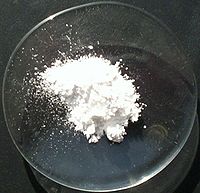
Photo from wikipedia
For high-quality and effective polishing of SiC, a novel polishing technique that combines anodic oxidation and mechanical polishing (AOMP) is proposed herein. To clarify the SiC surface anodic oxidation mechanism,… Click to show full abstract
For high-quality and effective polishing of SiC, a novel polishing technique that combines anodic oxidation and mechanical polishing (AOMP) is proposed herein. To clarify the SiC surface anodic oxidation mechanism, AOMP experiments were conducted. The results show that as a result of surface oxidation, the main elements of the modified surface were Si and O by X-ray diffraction (XRD), indicating that the SiC surface was modified and formed a SiO2 oxide layer. Micro Vickers hardness tests revealed that the hardness of the modified surface greatly decreased to 1/9 of that of the as-received surface, which was easy to remove. Considering the experimental results, an anodic oxidation process model is proposed herein based on the inner-outer double-directional diffusion theory. During the oxidation process, a transition layer containing silicon oxycarbide (Si-C-O) was formed between the SiO2 and SiC, the amount of which varied with the thickness of the oxide. Based on the Deal-Grove model, the relationship between the oxide layer thickness and oxidation time was determined, and the initial oxidation rate was 44.81 nm/min. The surface roughness after chemical mechanical polishing (CMP) was determined for different oxidation time and polishing time, and it was clear that when the anodic plasma oxidation rate matched the CMP rate, a just-polished surface was obtained.
Journal Title: International Journal of Electrochemical Science
Year Published: 2020
Link to full text (if available)
Share on Social Media: Sign Up to like & get
recommendations!